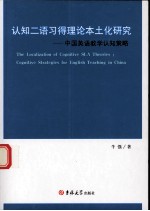图书介绍
认知二语习得理论本土化研究 中国英语教学认知策略pdf电子书版本下载

- 牛强著 著
- 出版社: 长春:吉林大学出版社
- ISBN:9787560162713
- 出版时间:2010
- 标注页数:350页
- 文件大小:13MB
- 文件页数:376页
- 主题词:第二语言-语言学习-研究
PDF下载
下载说明
认知二语习得理论本土化研究 中国英语教学认知策略PDF格式电子书版下载
下载的文件为RAR压缩包。需要使用解压软件进行解压得到PDF格式图书。建议使用BT下载工具Free Download Manager进行下载,简称FDM(免费,没有广告,支持多平台)。本站资源全部打包为BT种子。所以需要使用专业的BT下载软件进行下载。如 BitComet qBittorrent uTorrent等BT下载工具。迅雷目前由于本站不是热门资源。不推荐使用!后期资源热门了。安装了迅雷也可以迅雷进行下载!
(文件页数 要大于 标注页数,上中下等多册电子书除外)
注意:本站所有压缩包均有解压码: 点击下载压缩包解压工具
图书目录
Chapter 1 Cognitive theories relevant to second language acquisition 1
1.1 A general review of memory 2
1.1.1 Definition of memory:What is memory? 2
1.1.2 Types of memory 2
1.1.3 The mechanisms of memory:Register,retention and retrieval(3R) 12
1.1.4 Functions of Memory:What affects what we remember? 14
1.2 Mental lexicon 34
1.2.1 Dimensions of word knowledge:what is stored in the mental lexicon 35
1.2.2 Organization of the mental lexicon 38
1.2.3 Models of lexieal access 41
1.2.4 The representation of a bilingual's mental lexicon 43
1.3 Power-law learning 48
1.4 Characteristics of language skill learning 51
Conclusion 53
Chapter 2 Second language acquisition:key concepts and theories 55
2.1 Pre-cognitive SLA period:key figures and their contributions 56
2.1.1 Pit Corder and error analysis 56
2.1.2 Larry Selinker and Interlanguage fossilization 62
2.1.3 Stephen Krashen and his famous five hypotheses 68
2.1.4 Swain's Comprehensible Output hypothesis 77
2.1.5 Language transfer and mother tongue interference 78
2.1.6 Individual Differences or learner characteristics 81
2.2 Post-cognitive SLA period:representatives and their areas of research 89
2.2.1 Explicit knowledge versus implicit knowledge 90
2.2.2 Richard Schmidt's Attention hypothesis 94
2.2.3 Maclaughlin's information processing model 96
2.2.4 Anderson's Adaptive Control of Thought(ACT)model 99
2.2.5 Fodor and Modularity 101
2.2.6 Connectionist model of SLA 103
2.2.7 Mac Whinney's Competition Model 105
2.2.8 Pienemann and Processability theory 109
2.2.9 Nick Ellis and the Chunking Strategy in SLA 111
2.2.10 Bialystok's Analysis-Control model and distinction between analyzed and unanalyzed knowledge 114
2.2.11 VanPattern's Input and output hypothesis 117
Conclusion 121
Chapter 3 From Language Acquisition to Foreign Language Learning 122
3.1 From Language Acquisition to Foreign Language Learning 122
3.2 Left-hemisphere lateralization and Plasticity 125
3.3 Chomsky and his Universal Grammar 126
3.4 Language Learning:Types of comparisons and contrast 134
3.4.1 Child first language acquisition vs adult foreign language learning 136
3.4.2 Child second language acquisition vs adult second language acquisition 151
3.4.3 Secondlanguage acquisition vs foreign language learning 153
3.5 A pedagogical implication:Age of Acquisition 156
3.5.1 Language and Cognition:the effects of multilingualism 156
3.5.2 The Mediated Role of Language in the Development of Human Higher Mental Functions 160
3.5.3 Different approaches to learners of different ages 163
3.5.4 Implication:language planning in China 164
Conclusion 181
Chapter 4 Implications of cognitive theories for SLA:metacognitive strategies for FLL 183
4.1 Change of orientation on learner strategy research 183
4.2 Need of strategy instruction and learner autonomy 187
4.3 Ways to raise learners' consciousness of learner strategies 188
4.4 Metaognitive strategies in teaching grammar 190
4.4.1 Grammatical knowledge versus grammatical competence 190
4.4.2 Linguistic grammar versus pedagogic grammar 192
4.4.3 Grammar core and grammar peripherals 193
4.4.4 Comprehension ability and production ability 197
4.4.5 A tentative approach to grammar teaching 200
4.5 Metacognitive strategies in teaching vocabulary 202
4.5.1 Types of vocabulary 202
4.5.2 Metacognitive strategies in converting receptive vocabulary into productive vocabulary 205
Conclusion 214
Chapter 5 The Optimal Input and Optimal Output hypothesis 216
5.1 Psychological basis 217
5.1.1 Relation between language and thought 218
5.2 The optimal input hypothesis 223
5.2.1 The role of input 223
5.2.2 Characteristics of optimal input 236
5.3 The Optimal Output hypothesis 261
5.3.1 The role of output 265
5.3.2 Types of output 269
5.3.3 A Pedagogical Implication:Learning from output 278
Conclusion 282
Chapter 6 Foreign Language Teaching methodologies 284
6.1 The Grammar-Translation method 284
6.2 The Direct method 287
6.3 The Oral approach or the Situational language teaching 289
6.4 The Audiolingual Method 291
6.5 Communicative Language Teaching 293
6.6 Total Physical Response(TPR) 298
6.7 The Silent Way 300
6.8 Community Language Learning 301
6.9 The Natural Approach 302
6.10 Suggestopedia 303
6.11 Teaching English through movies—a Holistic Approach 303
Conclusion 308
Chapter 7 Foreign Language Testing 309
7.1 Types of tests and their functions 309
7.2 Backwash Effect(反拨效应) 312
7.3 Criteria of tests(测试的衡量标准) 315
7.4 Interpreting test scores 318
7.4.1 Measures of Central Tendency(趋中量数) 319
7.4.2 Measures of Dispersion(分散量数) 320
7.5 Item Analysis(单项分析) 321
7.6 A Sample of erroneous Multiple Choice Questions 324
7.7 A summary of the principles we should observe in designing good MCQ items 330
Bibliography 334